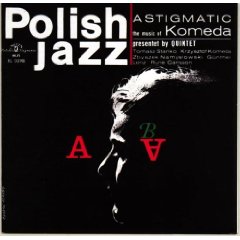Krzysztof Komeda – Astigmatic (1965)
Krzysztof Komeda – Astigmatic (1965)

1. Astigmatic
2. Kattorna
3. Svantetic
Artists: Krzysztof Komeda - piano Tomasz Stańko - trumpet Zbigniew Namysłowski – alto saxophone Günter Lenz - bass Rune Carlsson – drums
Krzysztof Komeda-Trzcinski (1931-1969), an extraordinary talented self-taught composer and pianist, became after his tragic, untimely death, a legend and a cult hero of Polish jazz. His music reflects not the growing of jazz in our country in the '60-s, but echoes the big influences: Bill Evan's refinement, Eric Dolphy's free and even John Coltrane's abandon. On this disc his partners are two eminent Polish masters-: Tomasz Stanko and Zbigniew Namyslowski and two excellent rhythm men. Gunter Lenz and Rune Carlsson. The title piece "Astigmatic", except for the beginning, presents little of ensemble interaction. Rather, we hear exciting dialogues by trumpet and piano or trumpet and bass. Komeda's piano dictates the levels of tension: it emerges, grows insisting, fades away and emerges again. Namyslowski's alto takes up backed by bass and drums. Lenz's solo opens the way for the drummer and then piano reappears. After a sudden take-off by the whole ensemble the piece! burns out in barely audible bass flageolets. "Kattorna" a disquieting music from the Danish movie by Carlssen (the title means Kittens), changes on this disc into real tour de force by Stanko, that reminds us of Mexican beguile from the siege of Alamo time. Komeda's exceptional illustrative talent made him the much valued composer of music to many movies and among them some by R. Polanski. "Svantetic", dedicated to Swedish poet Svante Forster, creates initially an impression of a dirge, but its main diatonic motif in d-minor (a Polish boy scouts song) is merely the nucleus of truly dramatic jazz development in which we hear much of Namyslowski's alto and also beautiful meditations by bass and piano. It seems to be the best piece by Komeda. However, structurally it has double ending: after the first, the drum solo leads to the reappearance of the initial theme that spans the whole, but the last sentence - not without the protest of others - belongs to the trumpet. ---Editorial Reviews
"Simply...ESSENTIAL!" -- Penguin Guide
download (mp3 @320 kbs):
uploaded yandex 4shared mega solidfiles zalivalka cloudmailru filecloudio oboom
Zmieniony (Środa, 07 Styczeń 2015 21:57)
